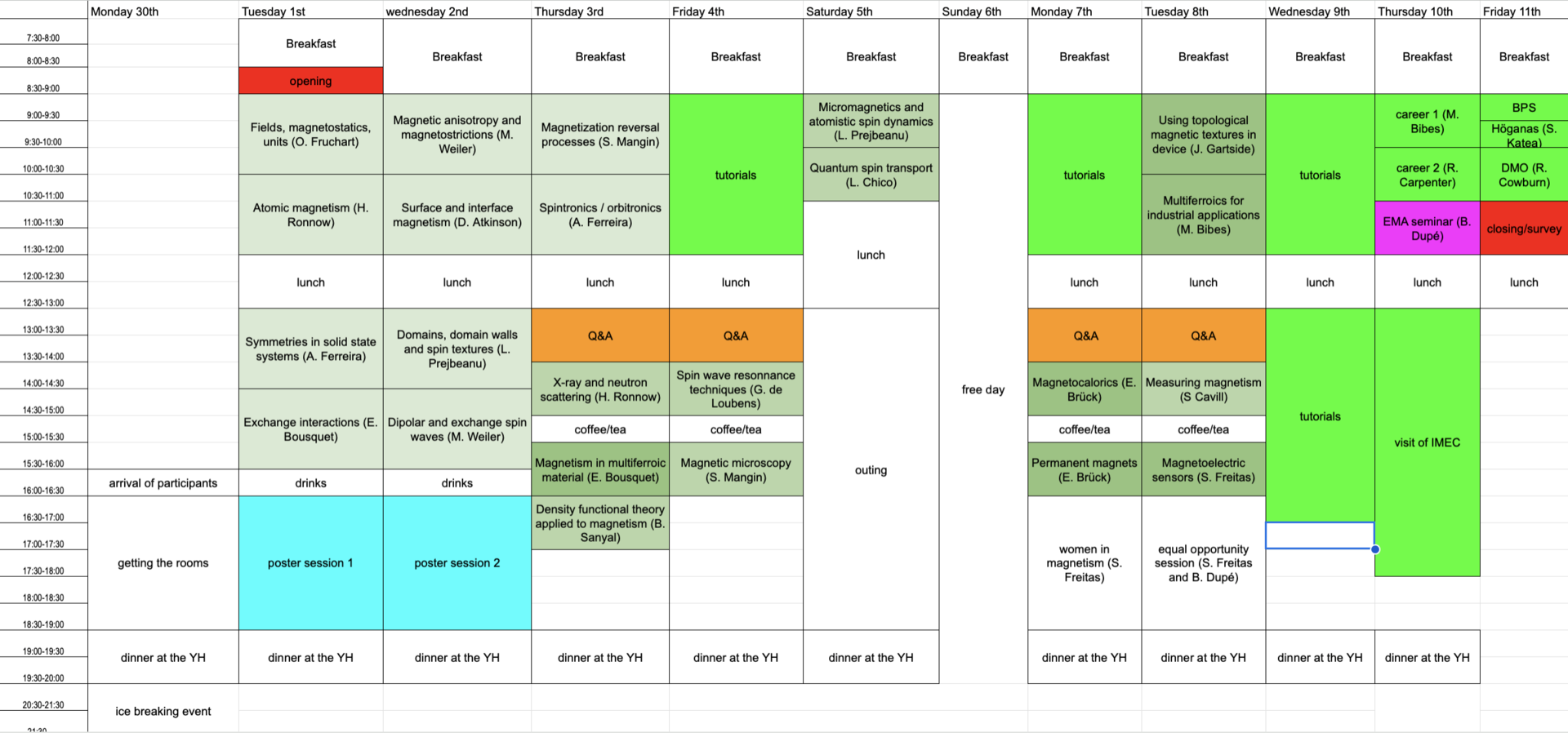Program
I. Fundamentals
- Fields, magnetostatics, units: Olivier Fruchart, Grenoble, France (Slides/Recording)
- Atomic magnetism: Hennrik Ronnow, Lausanne, Switzerland (Slides/Recording)
- Symmetries in solid state systems: Aires Ferreira, York, UK (Slides/Recording)
- Exchange interactions: Eric Bousquet, Liège, Belgium (Slides/Recording)
- Magnetic anisotropy and magnetosctricton: Mathias Weiler, Kaiserslautern, Germany (Slides/Recording)
- Surface and interface magnetism: Del Atkinson, Durham, UK (Slides/Recording)
- Domains, domain walls, spin textures: Liliana Prejbeanu, Grenoble, France (Slides/Recording)
- Dipolar and exchange spin waves: Mathias Weiler, Kaiserslautern, Germany (Slides/Recording)
- Magnetization reversal processes: Stéphan Mangin, Nancy, France (Slides/Recording)
- Spintronics / Orbitronics: Aires Ferreira, York, UK (Slides)
II. Techniques
- Introduction to neutron scattering: Hennrik Ronnow, Lausanne, Switzerland (Slides/Recording)
- Measuring magnetism: Stuart Cavill, York, UK (Slides/Recording)
- Spin-wave resonance techniques: Grégoire de Loubens, Paris, France (Slides/Recording)
- Magnetic microscopy: Stéphane Mangin, Nancy, France (Slides/Recording)
- Density functional theory applied to magnetism: Biplab Sanyal, Uppsala, Sweden (Slides/Recording)
- Micromagnetics and atomic spin dynamics: Liliana Prejbeanu, Grenoble, France (Slides/Recording)
- Quantum spin transport: Leonor Chico, Madrid, Spain (Slides/Recording)
III. Functions and applications
- Magnetocalorics: Ekkes Brück, Delft, The Netherlands (Slides/Recording)
- Permanent magnets: Ekkes Brück, Delft, The Netherlands (Slides/Recording)
- Magnetism in multiferroic materials: Eric Bousquet, Liège, Belgium (Slides/Recording)
- Magnetoresistive sensors: Susana Cardoso de Freitas, Porto, Portugal (Slides/Recording)
- Using topological magnetic textures in device: Jack Gartside , London, OK (Slides/Recording)
- Stabilizing skyrmions in multiferroic materials: Bertrand Dupé, Liège, Belgium (Slides/Recording)
- Multiferroics in industrial applications: Manuel Bibes, Paris, France (Slides/Recording)
IV. Industrial and career perspective
Practicals
Practical are organized to practice the use of numerical, analytical or experimental techniques, related to topics covered by the lectures. They are proposed both to onsite and online participants.
Question-Answer sessions (5-10h)
The purpose of a research School is to provide young scientists with the basics in a working field. With this respect interactivity between students and lecturers should be promoted. Like in the previous editions, a key aspect of this interactivity is the possibility to raise questions at the end as well as during the course of the lectures, both for onsite and online participants. Besides, several sessions of questions take place, during which the lecturers or voluntary students present in more detail issues raised by the students during the lectures or anonymously through a question-box.
Library
A library consisting of a large set of books dedicated to various aspects of Magnetism is on display during the entire School. Its purpose is first to get students aware of the existing books, get acquainted with their use, and also serve as a support for activities during the School.
Posters
We encourage participants to bring posters to present their work. Poster will be displayed at all times during the school, plus with dedicated poster tims slots. Students are also asked to present their poster in a one-slide teaser as an exercice to summarize their work. Several poster prizes will be awarded, including a voucher for free attendance to the next Joint European Magnetism Symposia conference.
Program







